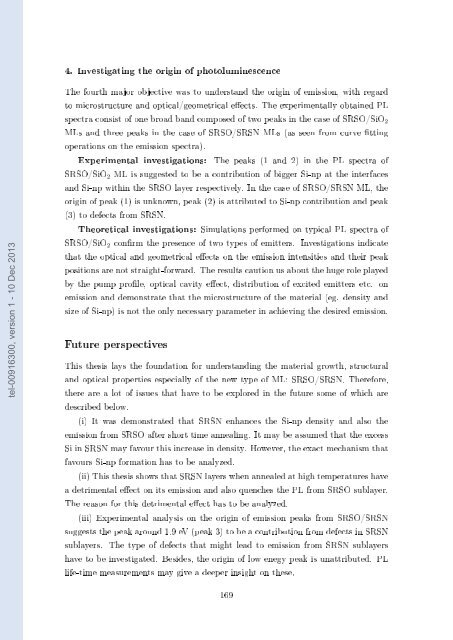Films minces à base de Si nanostructuré pour des cellules ...
Films minces à base de Si nanostructuré pour des cellules ...
Films minces à base de Si nanostructuré pour des cellules ...
Create successful ePaper yourself
Turn your PDF publications into a flip-book with our unique Google optimized e-Paper software.
4. Investigating the origin of photoluminescence<br />
tel-00916300, version 1 - 10 Dec 2013<br />
The fourth major objective was to un<strong>de</strong>rstand the origin of emission, with regard<br />
to microstructure and optical/geometrical eects. The experimentally obtained PL<br />
spectra consist of one broad band composed of two peaks in the case of SRSO/<strong>Si</strong>O 2<br />
MLs and three peaks in the case of SRSO/SRSN MLs (as seen from curve tting<br />
operations on the emission spectra).<br />
Experimental investigations: The peaks (1 and 2) in the PL spectra of<br />
SRSO/<strong>Si</strong>O 2 ML is suggested to be a contribution of bigger <strong>Si</strong>-np at the interfaces<br />
and <strong>Si</strong>-np within the SRSO layer respectively. In the case of SRSO/SRSN ML, the<br />
origin of peak (1) is unknown, peak (2) is attributed to <strong>Si</strong>-np contribution and peak<br />
(3) to <strong>de</strong>fects from SRSN.<br />
Theoretical investigations: <strong>Si</strong>mulations performed on typical PL spectra of<br />
SRSO/<strong>Si</strong>O 2 conrm the presence of two types of emitters. Investigations indicate<br />
that the optical and geometrical eects on the emission intensities and their peak<br />
positions are not straight-forward. The results caution us about the huge role played<br />
by the pump prole, optical cavity eect, distribution of excited emitters etc. on<br />
emission and <strong>de</strong>monstrate that the microstructure of the material (eg. <strong>de</strong>nsity and<br />
size of <strong>Si</strong>-np) is not the only necessary parameter in achieving the <strong>de</strong>sired emission.<br />
Future perspectives<br />
This thesis lays the foundation for un<strong>de</strong>rstanding the material growth, structural<br />
and optical properties especially of the new type of ML: SRSO/SRSN. Therefore,<br />
there are a lot of issues that have to be explored in the future some of which are<br />
<strong>de</strong>scribed below.<br />
(i) It was <strong>de</strong>monstrated that SRSN enhances the <strong>Si</strong>-np <strong>de</strong>nsity and also the<br />
emission from SRSO after short time annealing. It may be assumed that the excess<br />
<strong>Si</strong> in SRSN may favour this increase in <strong>de</strong>nsity. However, the exact mechanism that<br />
favours <strong>Si</strong>-np formation has to be analyzed.<br />
(ii) This thesis shows that SRSN layers when annealed at high temperatures have<br />
a <strong>de</strong>trimental eect on its emission and also quenches the PL from SRSO sublayer.<br />
The reason for this <strong>de</strong>trimental eect has to be analyzed.<br />
(iii) Experimental analysis on the origin of emission peaks from SRSO/SRSN<br />
suggests the peak around 1.9 eV (peak 3) to be a contribution from <strong>de</strong>fects in SRSN<br />
sublayers. The type of <strong>de</strong>fects that might lead to emission from SRSN sublayers<br />
have to be investigated. Besi<strong>de</strong>s, the origin of low enegy peak is unattributed. PL<br />
life-time measurements may give a <strong>de</strong>eper insight on these.<br />
169
















